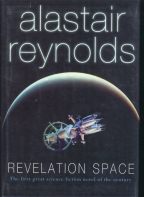Revelation Space
Victor Gollancz / Orion
UK Hardcover First
ISBN 0-575-06875-2
Publication Date: 03-09-2000
476 Pages; £17.99
Date Reviewed: 07-25-02
Reviewed by Rick Kleffel © 2002
|

|
|
REFERENCES
|
COLUMNS
|
|
Science
Fiction, Horror
|
03-21-02,
04-15-02,
07-02-02,
07-30-02,
09-20-02,
10-03-02,
10-08-02,
12-13-02,
01-07-03,
01-27-03,
02-25-03,
05-15-03,
06-14-04
|
Space operas can easily spend too much time in the vacuum. The
gulf between the worlds becomes a gulf between the reader's
experiences and those of the characters. When readers don't get a
chance to connect intimately with the characters, the awe that is
aspired for is too easily translated into a yawn. 'Revelation Space',
the first novel by Alastair Reynolds connects the readers with the
characters in gritty, detailed prose that has the ring of reality.
Starting in an ice storm at an archaeological dig, 'Revelation Space'
dials the reader out of this world and into the clever universe that
Reynolds has mapped. His writing is organic, dense and detailed. As
an astrophysicist for the European Space Agency, he's able to bring
an air of complete authenticity as he creates technologies to explore
space and cultures that inhabit worlds. Moreover, he's willing to
answer the hard questions. He doesn't handwave hyperdrives to give
his characters an edge. 'Revelation Space' is set a very relativistic
universe, where the rules are the rules, and they're the rules we all
know. People, being people, have just had to figure out a way to work
with them.
The dig that begins the novel unearths something very disturbing
for scientist Dan Sylveste. A patrician son of the wealthy, Sylveste
does not welcome any interruption in his quest to find out what
happened to the previous inhabitants of the planet Resurgam. They
were extinguished en masse, just as they were on the verge of
achieving interstellar space flight. It appears that this might not
be purely accidental. He requires the assistance of the crew of
Nostalgia for Infinity, a huge gothic spaceship cathedral with a
cache of "hell class" weapons. But there's a tiny problem with the
Captain. And Ana Khouri, a recent addition to the crew has an
ulterior motive for joining.
'Revelation Space' delivers a consistently enthralling and
entertaining vision of mankind in deep space. Because the ship cannot
travel faster than light, but rather only at "lighthugger" speed,
action in the novel is spread out in time as well as space. And,
there are no 'ansibles', so news travels no faster than humanity can.
This allows Reynolds to create tension in a number of ways on a
number of levels. He understands that science fiction can be written
in three dimensions, and he doesn't stint the human dimension. Ana
Khouri and the Triumvir Ilia Volyova are complex women characters
with a dark edge not often found in SF.
In fact, darkness is a theme running through 'Revelation Space',
which, though it deals with major SF themes, often has the feel of a
monsterific horror novel. Reynolds prose really helps in this effect,
and surely the Nostalgia for Infinity is one of the most interesting
ships we've seen in the SF world in a long time. Reynolds describes
it as if it was a living haunted house, and has a very clever way to
bring it to life. It's not that living ships are anything
particularly new in SF, but Reynolds original vision and careful
prose help create a very creepy, believable space cathedral.
Given the old writer's tenet about writing what you know, the
astrophysicist's experience and knowledge that Reynolds brings to
bear means that he can effortlessly invent, describe and create some
rather fantastic imagery in space. Because he's got the readers
dialed in to the characters, when he brings on the awesome, he
manages to translate it to the reader quite effectively. 'Revelation
Space' more than lives up to its title: not only in the revelations
within the novel itself, but most importantly in the revelation of
Alastair Reynolds as a major writer who starts literally light years
beyond any readers' expectations.
